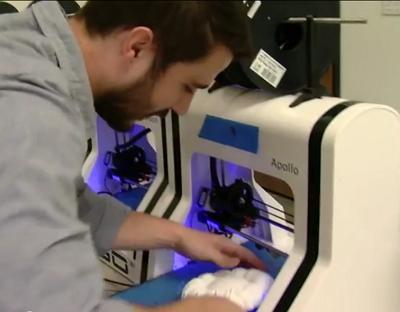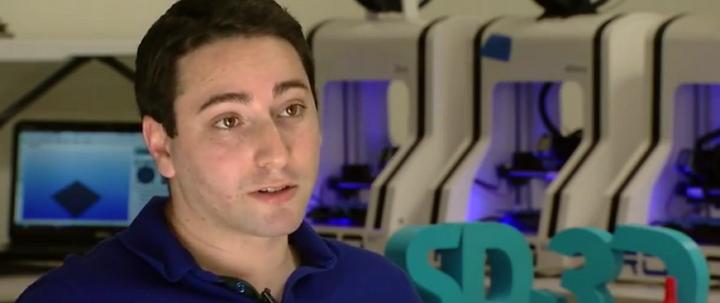Sean Aranda of SD3D in San Diego, California says the company’s adaptive build environment is currently in alpha testing, and he adds they’re confident that their entire automated, distributed manufacturing network cut down on failed prints from desktop printers to below 1% in total.
David Feeney and Bennett Berger co-founded SD3D, and they call it “a bootstrapped, two-guys-will-print-it operation.”
SD3D Printing Inc. launched last year, and they recently opened their first 3D printer farm which allows clients to purchase and then house their 3D printer on-site. It works like this: when a client is ready to use their 3D printer, the process is managed on-site by technicians at SD3D who use the company’s open source Adaptive Build Environment (ABE) software to manage the job.
Clients pay a service fee which, depending on the length of a contract, might run around $5.89 per print for a year and the cost of filament which runs around $30 per kg of PLA or ABS.
Feeney says the key is ABE.
“ABE can be thought of as a universal smart cover for open source desktop 3D printers. The goal was to create a product that could bridge the quality and reliability gap between the affordable printers utilizing generic materials and the expensive enterprise level printers,” Feeney says. “All of the key elements that go into making a perfect print are monitored and controlled universally such that ABE can be easily removed and installed on just about any desktop 3D printer in less than a minute. ABE takes all of the technicalities out of being a 3D printing technician.”
The ABE envelope controls humidity and vibration monitoring, automatic precision bed leveling, thermal protection, diagnostics and alerts and automated material selection, and Feeney says the platform is currently being assembled. It will be tested throughout the month of June, and he says the initial units will be ready in time for the opening of North America’s first FabCafe in July.
“SD3D is changing the desktop 3D printing market with our innovative technology,” Feeney says.
The system includes filament monitoring which handles precision tracking of filament position and diameter to provide “closed loop extrusion control.” A monitor acts as a solution for filament jams, material shearing, and under or over extrusion. Feeney says precision optical diameter monitoring is provided, which allows for continuous filament diameter measurements with a resolution of 100 microns. The measurements automate extrusion flow rate changes throughout the print to provide extremely tight print tolerances.
A dual geared extruder drive enhances traction for reliable high-speed material extrusion. SD3D’s dual geared extruder drive is the world’s first variable axis, multi-geared extruder drive running off a single stepper motor. It’s configured to run 3.0mm filaments through nozzle diameters ranging from 0.25mm through 1.2mm via an encoded NEMA 11 stepper with a 22:1 gear reduction. It’s a drop-in replacement for any existing extruder assembly mounted to a standardized Greg Wade’s adapter plate.
The system also features non-destructive autoejection of completed prints to allow for continuous, 24/7 production printing.
The ABE system provides the control systems to allow engineering grade materials to print reliably using a set of modular panels with variable insulation properties. Each ABE panel can absorb up to 80W of transient thermal energy, and multiple panel sets can be configured to reduce temperature gradients across the build chamber to within 2 degrees centigrade.
A material detection and inventory management with an ERP system allows for lean FDM manufacturing and just-in-time (JIT) inventory control.
The SD3D ABE functionality offers RFID-based, automatic material detection and the system is used to track how much material is remaining on each spool and automatically renew filament inventory once a minimum threshold is met. Users are alerted if material inventory falls short to complete a pending print.
What do you think of the SD3D plan to make 3D printing more efficient and production-ready? Let us know in the SD3D and ABE forum thread on 3DPB.com. Below is a look at the latest in 3D printing tech from SD3D.

Subscribe to Our Email Newsletter
Stay up-to-date on all the latest news from the 3D printing industry and receive information and offers from third party vendors.
You May Also Like
Precision at the Microscale: UK Researchers Advance Medical Devices with BMF’s 3D Printing Tech
University of Nottingham researchers are using Boston Micro Fabrication‘s (BMF) 3D printing technology to develop medical devices that improve compatibility with human tissue. Funded by a UK grant, this project...
3D Printing Webinar and Event Roundup: April 21, 2024
It’s another busy week of webinars and events, starting with Hannover Messe in Germany and continuing with Metalcasting Congress, Chinaplas, TechBlick’s Innovation Festival, and more. Stratasys continues its advanced training...
3D Printing Webinar and Event Roundup: March 17, 2024
It’s another busy week of webinars and events, including SALMED 2024 and AM Forum in Berlin. Stratasys continues its in-person training and is offering two webinars, ASTM is holding a...
3D Printed Micro Antenna is 15% Smaller and 6X Lighter
Horizon Microtechnologies has achieved success in creating a high-frequency D-Band horn antenna through micro 3D printing. However, this achievement did not rely solely on 3D printing; it involved a combination...































